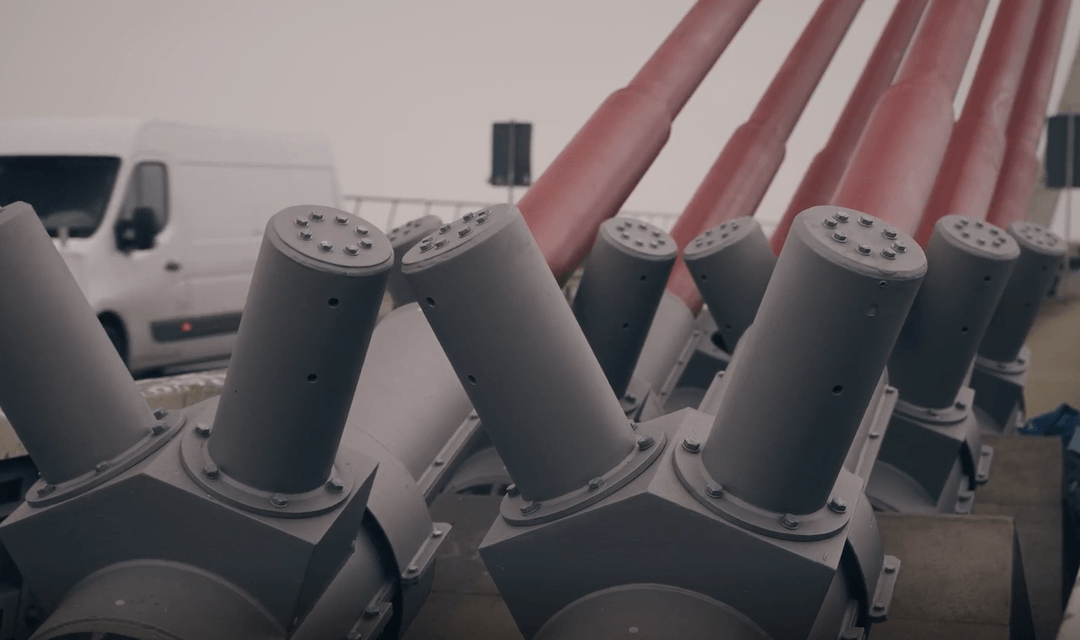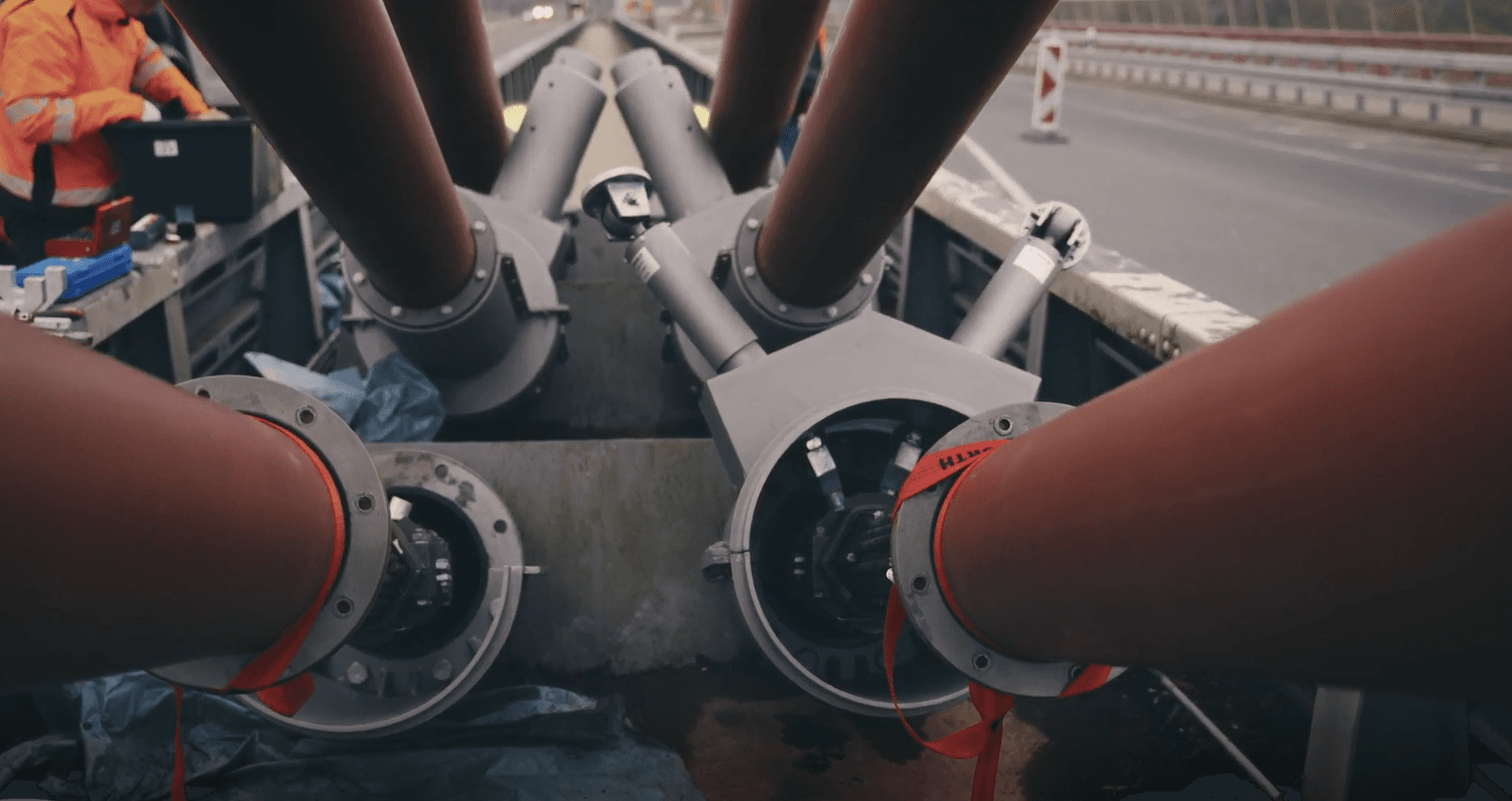
Damper replacement & retrofit
DYWIDAG tackles the challenges of stay cable vibration control with precision. Delivering retrofit solutions to add new damping systems where none exist, and replacement services to upgrade or renew ageing units. Our engineered solutions restore stability, extend cable life, and keep bridges performing safely for decades.
Safeguarding cable-stayed structures
Without adequate damping systems, cable stayed bridges and structures are vulnerable to excessive vibrations caused by wind, rain–wind interaction, and traffic-induced excitation. Over time, these vibrations can lead to fatigue damage in cables, anchorages, and surrounding structural components. In severe cases, uncontrolled oscillations may compromise structural integrity, increase maintenance costs, and shorten the bridge’s service life.
Cable dampers play a critical role in preventing this. By dissipating vibrational energy, they reduce oscillation amplitudes, protect structural connections, and maintain long-term serviceability. Modern damping systems are designed to perform reliably across a range of environmental conditions and vibration modes.
DYWIDAG provides a full spectrum of damper technologies; including viscous, hydraulic, tuned mass, and cross-tie systems, each engineered to optimise vibration control and extend the lifespan of stay cable bridges.
From testing to installation: A complete solution
In the case of assessing cable stayed bridge dampers, each project begins with a comprehensive vibration assessment, where our engineers measure cable motion, frequency, and amplitude to understand the root cause of instability. Based on this data, we design tailored dampers for each cable, engineering precise connection details for seamless integration with the cable and structure.
Our solutions control both in-plane and out-of-plane vibrations, ensuring reliable long-term performance. After installation, we conduct on-site vibration testing to verify damping efficiency and document results.
DYWIDAG provides a complete stay cable protection solution, combining bridge maintenance services with inspection, testing, installation and strengthening services to fully support your project from day one.


What DYWIDAG deliver
Assessment & modelling
Comprehensive vibration surveys and analytical modeling to understand cable dynamics, identify fatigue risks, and define damping requirements.
Design & engineering
Tailored damper configurations, connection details, and bracket solutions designed for precise performance and seamless system integration.
Installation & commissioning
Low‑disruption replacement or retrofit using rope access or robotic methods, followed by on‑site vibration testing to verify damping efficiency.
Lifecycle support
O&M documentation, inspection schedules, spare kits, and optional SHM integration to ensure sustained, measurable performance over time.
Identifying and solving cable vibration issues
Stay cable vibrations can emerge unexpectedly and escalate quickly, driven by changes in wind climate, rain–wind interaction, traffic loading, or aerodynamic modifications to the deck. Left unmanaged, these movements accelerate fatigue, increase maintenance costs, and shorten the service life of both cables and anchorages.
DYWIDAG resolves a full range of vibration challenges, including:
Rain–wind vibrations – large, slow oscillations triggered by surface water flow.
Aeolian vibrations – high-frequency, low-amplitude motions caused by steady winds.
Traffic-induced excitation – dynamic movements linked to repetitive live loads.
Parametric excitation – amplification of motion under certain wind and cable tension conditions.
Cable–deck interaction – coupled vibrations between cables, deck, and pylons.
Early detection is essential
Signs that your bridge may require damping, retrofit, or damper replacement include:
Visible cable movement during moderate wind conditions.
Recurring vibration reports or alerts during routine inspections.
Noise, rattling, or noticeable oscillation at anchorage points.
Leaking or corroded dampers, cracked housings, or worn components.
Changes in bridge geometry or conditions — such as new barriers, resurfacing, or wind shielding — that alter aerodynamic behaviour.
Historical vibration events that are becoming more frequent or more severe.
Addressing these issues early helps prevent structural damage and ensures the long-term reliability of stay cable systems. DYWIDAG provides the assessment, design, and proven damping technologies to restore control and extend asset life.
From diagnostics to installation, we deliver proven damping solutions that keep bridges safer and longer-lasting.
Integrated process and smart monitoring
Every retrofit or replacement project follows a structured workflow to deliver measurable vibration reduction and long-term cable performance. It begins with a detailed assessment of cable behaviour, followed by tailored damper design, precise installation, and on-site testing to verify effectiveness.
To ensure performance remains stable over time, DYWIDAG offers integrated monitoring solutions. By combining on-site sensors with digital analytics, our systems track vibration frequencies, amplitudes, and environmental conditions in real time. This continuous insight helps detect early signs of instability, confirm damper efficiency, and support data-driven maintenance planning throughout the bridge’s service life.
01
Detailed on-site measurements capture cable frequencies, amplitudes, mode shapes, and environmental conditions to define the exact damping performance required.
02
Our engineers identify primary vibration drivers, such as wind climate, rain–wind effects, deck aerodynamics, and traffic-induced forces to diagnose root causes accurately.
03
We engineer bespoke damping solutions using simulation, force–velocity modelling, and structural verification to ensure optimal performance and compatibility with existing geometry.
04
Dampers, brackets, or cross-ties are fabricated, mounted, and calibrated using rope access or specialist tooling to minimise disruption and ensure precise alignment.
05
Post-installation measurements verify vibration reduction, confirm system behaviour under real conditions, and provide documented evidence of performance improvements.
06
Optional sensor integration enables long-term tracking of cable dynamics, early detection of changes, and data-driven maintenance planning.
Damper systems for every requirement
Different cable-stayed structures demand different damping solutions depending on their geometry, vibration behaviour, and environmental exposure. DYWIDAG engineers select and configure the most effective system for each structure.
By fixation type
Internal dampers – positioned within the anchorage zone for optimal protection and discreet design.
External dampers – mounted on the bridge deck for accessibility and retrofit ease.
By damping direction
In-plane damping – controls motion in the cable plane (parallel movement is also out of plane)
Out-of-plane damping – out of the cable plane in transverse direction (no torsion)
By damper technology
Viscous dampers – provide consistent energy dissipation and adaptable performance over a broad frequency range.
Friction dampers – durable and simple, ideal where maintenance access is limited.
Rubber dampers – flexible and compact, suited for moderate vibration amplitudes and environmental resistance.


What makes DYWIDAG the right partner for cable damping?
Full lifecycle damper services
From diagnostics to installation, we manage every stage of the damping process - ensuring precise design, seamless integration, and verified performance.
Low-disruption delivery
Using rope access where necessary, and custom tooling, our teams retrofit or replace dampers with minimal closures and downtime.
Proven global performance
Decades of experience across climates and bridge types ensure reliable solutions tailored to real-world conditions. From concept to completion, we bring expert precision to every step of cable damping .
Custome fit for every bridge
We offer a wide selection of damper systems, including internal and external systems, as well as viscous, rubber, friction, and semi-active dampers, ensuring the right fit for your project.
Our related services
Stay Cable Protection
Providing in-depth technical advice and advanced repair technologies customized to your project's unique conditions.
Stay cable sheath repair
Essential stay cable sheath and cover repair, and replacement services to keep your cable-stayed structures safe and performing at their best.
Instalación de tirantes
DYWIDAG ofrece un servicio completo de instalación y tensado de tirantes.
Rope access
Safe and efficient access alternative allowing the delivery of technically complex work safely and efficiently.
Bridge Monitoring
Enhance bridge safety and longevity with real-time Structural Health Monitoring (SHM).
Inspección y pruebas
Garantice la seguridad, el rendimiento y la longevidad de sus infraestructuras con servicios integrales de inspección y pruebas, que incluyen inspecciones visuales, ensayos no destructivos y evaluaciones geotécnicas.
Amortiguadores
Prolongación de la vida útil de sus cables.
Revestimientos de cables Stay
Revestimientos de estancias y amortiguadores que protegen contra las influencias ambientales.
Tirantes
Diseñado para no necesitar mantenimiento.
Protección contra explosiones
Protección contra explosiones para tirantes: Cumple las directrices de seguridad de puentes de la AASHTO.
Protección contra incendios
Evitar fallos en los cables durante incendios extremos.
Soluciones de deshielo
Control del hielo y deshielo de los cables de los tirantes con soluciones pasivas y activas.
Iluminación de cables integrada
Pantallas LED integradas con un impacto mínimo de la carga aerodinámica.
Anclaje de horquilla
Admite un diseño estructural de pilón económico.
Sistema de caja de anclaje DYNA Link (solución de asiento)
Solución de sillín con valor añadido.
Sistema DYNA Grip Standard
Alto rendimiento a la fatiga y excelente durabilidad.
Cableskin
Protección duradera contra los rayos UV y la corrosión con una interrupción mínima del tráfico.
